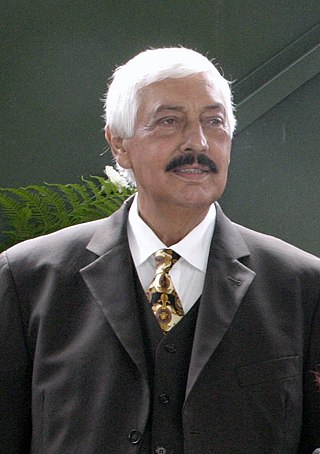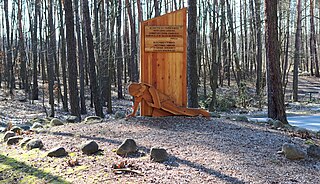
Romani Rose (born 1946 at Heidelberg, Germany) is a Romany activist and head of the Central Council of German Sinti and Roma. He lost 13 relatives in the Holocaust.

Romani Rose (born 1946 at Heidelberg, Germany) is a Romany activist and head of the Central Council of German Sinti and Roma. He lost 13 relatives in the Holocaust.
Rose was born in Heidelberg in 1946. Until 1982 he lived there as an independent businessman. At the founding of the Central Council in 1982 he was voted to the position of Chairman by the delegates of the member organisations – then nine, now 16 state and regional associations – and since then has been confirmed in his post every four years at the member meetings. From 1991 Rose took over the management of the Documentation and Culture Centre of German Sinti and Roma in Heidelberg. For years he has been known by the federal and state governments for his resoluteness and for his persistent and unyielding work.
Together with the Chairpersons of the national minorities in Germany Rose leads the Minority Council, which was founded on September 9, 2004. It is the union of the umbrella organisations of the four national minorities which belong to the German nation and have always been resident and autochthonous here: The DOMOWINA of the Sorbs, the Friesian Council, the South Schleswig Association of the Danish minority, and the Central Council of German Sinti and Roma. Along with delegates of minorities from the USA, Mexico, Argentina, Japan, India, Sri Lanka, France and Holland Rose is also a member of the management committee of the International Movement Against Discrimination and Racism (IMADR) founded in Tokyo in 1988.
A considerable motivation for Rose's efforts is his personal connection to the past. Thirteen direct relatives of Romani Rose were murdered in concentration camps under National Socialism, including his grandparents in the camps Auschwitz and Ravensbrueck. His father, Oskar Rose, survived on the run and in the underground. Romani Rose's uncle, Vincenz Rose, survived the extermination camp Auschwitz, medical experiments in the Natzweiler concentration camp, and slave work for Daimler-Benz in the tunnels of the KZ Neckarelz/Obrigheim. In 1972 Vincenz Rose founded the first self organisation of German Sinti, the Central Committee of Sinti in West Germany , in which the then not even 13 year old Romani Rose helped out.
Since June 1979 he has led the work for the civil rights of German Sinti and Roma before the eyes of the German as well as the international public; he has also fought for their protection from racism and discrimination, for compensation for the survivors of the Holocaust – at the same time announcing the magnitude and the historical importance of the genocide of 500,000 Sinti and Roma in National Socialist occupied Europe. In May 1995, in cooperation with the member organisations of the Central Council, Rose achieved recognition for German Sinti and Roma as a national minority in Germany with their own minority language, connected with their goal of equal participation in social and political life.
Rose was also one of the driving forces behind the Memorial to the Sinti and Roma Victims of National Socialism in Berlin. [1]

The Romani Holocaust was the genocide of European Roma and Sinti people during World War II. Beginning in 1933, Nazi Germany systematically persecuted the European Roma, Sinti and other peoples pejoratively labeled 'Gypsy' through forcible internment and compulsory sterilization. German authorities summarily and arbitrarily subjected Romani people to incarceration, forced labor, deportation and mass murder in concentration and extermination camps.

The Sinti are a subgroup of Romani people. They are found mostly in Germany, France and Italy and Central Europe, numbering some 200,000 people. They were traditionally itinerant, but today only a small percentage of Sinti remain unsettled. In earlier times, they frequently lived on the outskirts of communities.

Erwin Teufel is a German politician of the CDU.

The inverted black triangle was an identification badge used in Nazi concentration camps to mark prisoners designated asozial and arbeitsscheu ("work-shy"). The Roma and Sinti people were considered asocial and tagged with the black triangle. The designation also included disabled individuals, alcoholics, beggars, homeless people, nomads, prostitutes, and violators of laws prohibiting sexual relations between Aryans and Jews. Women also deemed to be anti-social included nonconformists.

Ceija Stojka was an Austrian Romani writer, painter, activist, and musician, and survivor of the Holocaust.
The Central Council of German Sinti and Roma is a German Romani rights group based in Heidelberg, Germany. It is headed by Romani Rose, who lost 13 members of his close family in the Romani Holocaust. The organization is a member of the Federal Union of European Nationalities.

The Documentation and Cultural Centre of German Sinti and Roma was established in Heidelberg, Germany, in the early 1990s, as a memorial to Sinti and Roma people who were killed by the National Socialists Party. After several years of extension work collecting stories from the victims, conducting research, and conversion, the building complex was ceremonially opened to the public on 16 March 1997, and was supported by the attendance of many Roma and Sinti survivors. It is the world's first permanent exhibition on the genocide perpetrated upon the Sinti and Roma by the Nazis. The documentation Centre has three levels and covers an area of almost 700 square meters, and traces the history and stories of the persecution of the Sinti and Roma under National Socialism. The institution is overseen by Central Council of German Sinti and Roma, supported by the city of Heidelberg, and is the beneficiary of special funds from the German Federal Government and the land of Baden-Württemberg.

Zoni Weisz is a Sinto Holocaust survivor from the Netherlands working in the Dutch floral industry.
The European Civil Rights Prize of the Sinti and Roma was founded in November 2007 in Heidelberg by the Central Council of German Sinti and Roma, the Documentation and Cultural Centre of German Sinti and Roma and the Manfred Lautenschläger Foundation. The international prize is endowed with 15,000 Euro by the Foundation. It was awarded for the first time in December 2008.

Hugo Adolf Höllenreiner was a Sinti survivor of the Porajmos during the Nazi dictatorship.

The Memorial to the Sinti and Roma Victims of National Socialism is a memorial in Berlin, Germany. The monument is dedicated to the memory of the 220,000 – 500,000 people murdered in the Porajmos – the Nazi genocide of the European Sinti and Roma peoples. It was designed by Dani Karavan and was officially opened on 24 October 2012 by German Chancellor Angela Merkel in the presence of President Joachim Gauck.
Roma Routes was established in 2007 to encourage the study of European heritage and culture. The project was established by the European Union and ended in 2013. The main purpose of Roma Route was to break the "cultural barrier" between the Roma and Non-Roma. Roma is a very lonely group in Europe, and most European countries have "discrimination" against Roma. Discrimination in most European countries also prevents Roma's culture from spreading worldwide. Through Roma Route, the European Union hopes to change the living conditions of the Roma and enhance the cultural communication of the Roma to the world.

The Roma Holocaust Memorial Day is a memorial day that commemorates the victims of the Romani genocide (Porajmos), which resulted in the murder of an estimated 220,000–500,000 Romani people by Nazi Germany and its collaborators during World War II. The date of 2 August was chosen for the memorial because on the night of 2–3 August 1944, 2,897 Roma, mostly women, children and elderly people, were killed in the Gypsy family camp (Zigeunerfamilienlager) at Auschwitz concentration camp. Some countries have chosen to commemorate the genocide on different dates.
Margarete Kraus was a Roma woman who was persecuted during the Porajmos, imprisoned at Auschwitz and Ravensbruck. Her experience was recorded in later life by the photographer Reimar Gilsenbach.
Romani people in the Netherlands are Romani people who live in the Netherlands; part of the broader Romani diaspora. Though they represent a small portion of the national population, the plight of those in the Roma community has received ongoing national attention.
Lily Franz (1924–2011), born Adele Franz, married as Lily van Angeren, published as Lily van Angeren-Franz) was a Sintezza writer. She was arrested with her family in 1943 and taken to Auschwitz concentration camp as part of the Romani Holocaust. Franz survived the camp, testifying against a SS officer. She lived in the Netherlands and published a memoir.
Elisabeth Guttenberger was a German Holocaust survivor and human rights activist. Of Sinti origin, she survived the Romani Holocaust and testified at the Frankfurt Auschwitz trials after having been interned at the Gypsy family camp.

Philomena Franz was a Sinti writer and activist from Germany, who was a survivor of the Romani Holocaust, having been imprisoned in Auschwitz. She later published works that recounted her experiences and was recognised as a significant voice in Romani literature.
Anita Awosusi is a German writer, musician, documentary filmmaker and human rights activist. Herself a Sinti woman, she has been active in campaigns for the rights of the Sinti and Romani people. Since the 1990s, she has published works on the history of the Romani Holocaust, on the music and on stereotyped representations of Sinti and Roma.

Else Baker is a survivor of the Auschwitz II-Birkenau concentration camp.